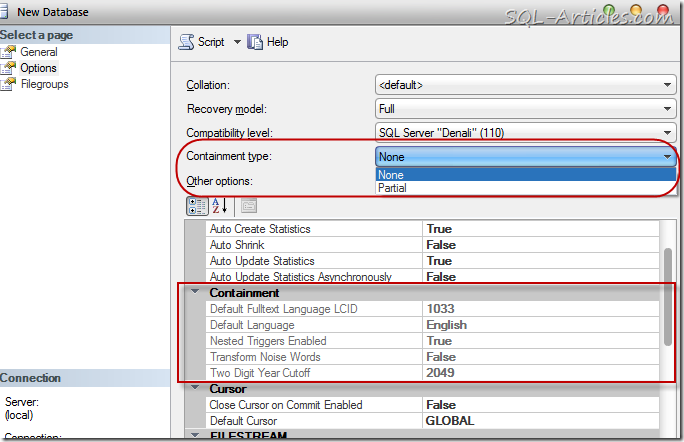A contained database is a database that is isolated from other databases and from the instance of SQL Server that hosts the database. SQL Server 2012 helps user to isolate their database from the instance in 4 ways.
- Much of the metadata that describes a database is maintained in the database. (In addition to, or instead of, maintaining metadata in the master database.)
- All metadata are defined using the same collation.
- User authentication can be performed by the database, reducing the databases dependency on the logins of the instance of SQL Server.
Requirements of contained databases.
- It is required to enable contained databases on the instance.
- The contained database needs to be added to the connection string or specified when connecting via SQL Server Management Studio
Partial containment is enabled using the CREATE DATABASE and ALTER DATABASE statements or by using SQL Server Management Studio.
How to configure contained database:
EXEC SP_CONFIGURE 'show advanced options',1GORECONFIGUREGOEXEC SP_CONFIGURE 'contained database authentication',1GORECONFIGUREGOUSE [master]GOCREATE DATABASE [ContainedDB] CONTAINMENT = PARTIAL
Found some disadvantages of Contained Database:
Connection strings
Connection strings to a contained database must explicitly specify the database in the connection string. You can no longer rely on the login's default database to establish a connection; if you don't specify a database, SQL Server is not going to step through all the contained databases and try to find any database where your credentials may match.
Cross-db queries
Even if you create the same user with the same password in two different contained databases on the same server, your application will not be able to perform cross-database queries. The usernames and passwords may be the same, but they're not the same user. The reason for this? If you have contained databases on a hosted server, you shouldn't be prevented from having the same contained user as someone else who happens to be using the same hosted server. When full containment arrives (likely in the version after SQL Server 2012), cross-database queries will absolutely be prohibited anyway. I highly, highly, highly recommend that you don't create server-level logins with the same name as contained database users, and try to avoid creating the same contained user name in multiple contained databases.
Synonyms
Most 3- and 4-part names are easy to identify, and appear in a DMV. However if you create a synonym that points to a 3- or 4-part name, these do not show up in the DMV. So if you make heavy use of synonyms, it is possible that you will miss some external dependencies, and this can cause problems at the point where you migrate the database to a different server. I complained about this issue, but it was closed as "by design." (Note that the DMV will also miss 3- and 4-part names that are constructed via dynamic SQL.)
Password policy
If you have created a contained database user on a system without a password policy in place, you may find it hard to create the same user on a different system that does have a password policy in place. This is because the
CREATE USER syntax does not support bypassing the password policy. I filed a bug about this problem, and it remains open. And it seems strange to me that on a system with a password policy in place, you can create a server-level login that easily bypasses the policy, but you can't create a database user that does so - even though this user is inherently less of a security risk.
Collation
Since we can no longer rely on the collation of tempdb, you may need to change any code that currently uses explicit collation or
DATABASE_DEFAULT to use CATALOG_DEFAULT instead. See this BOL article for some potential issues.
IntelliSense
If you connect to a contained database as a contained user, SSMS will not fully support IntelliSense. You'll get basic underlining for syntax errors, but no auto-complete lists or tooltips and all the fun stuff. I filed a bug about this issue, and it remains open.
SQL Server Data Tools
If you are planning to use SSDT for database development, there currently isn't full support for contained databases. Which really just means that building the project won't fail if you use some feature or syntax that breaks containment, since SSDT currently doesn't know what containment is and what might break it.
ALTER DATABASE
When running an
ALTER DATABASE command from within the context of a contained database, rRather than ALTER DATABASE foo you will need to use ALTER DATABASE CURRENT - this is so that if the database is moved, renamed, etc. these commands don't need to know anything about their external context or reference.
A few others
Some things you probably shouldn't still be using but nonetheless should be mentioned in the list of things that aren't supported or are deprecated and shouldn't be used in contained databases:
- numbered procedures
- temporary procedures
- collation changes in bound objects
- change data capture
- change tracking
- replication